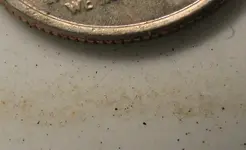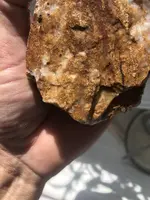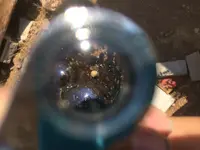Tahoegold
Sr. Member
- Joined
- Mar 7, 2016
- Messages
- 304
- Reaction score
- 304
- Golden Thread
- 0
- Location
- Carson City, NV
- Detector(s) used
- Compadre, Gold Racer, White's TRX,Bazooka GT 24",God Hog mats,Grizzly Gold Trap Motherload, Harbor freight 9 function, Cintech pinpointer, Determination
- Primary Interest:
- Prospecting
Hi all,
The other day I found a patch of gold in a highbank. I've been sampling to find the parameters. So, I didn't move much dirt. I used a snuffer bottle to grab the tiny -50 mesh I would say and took that plus some of the sands surrounding these pieces from my pan. I am being careful and gentil to recover as small of gold as I can. I went home with only my snuffed material. I then decided to try a process I saw on line that uses one small dish inside a slightly larger dish. Then ran a steady stream on one side of the small dish pushing the black sands out the opposite side like the blue bowl process. To my surprise, it really worked. I would say -100 stayed and only 4 bits of black sand remained. I had about 20 pieces of gold. Then comes the interesting part. I took the bigger of the bowles and tried to swish the black sands around to see if any gold spilled into it. No,not even a tiny speck. Upon setting this bowl down I noticed some material forming a line. It was moving like mud does in water. You know, cloudy swirling color. This material, however, quickly settled into a trough on the bowl. I thought, humm, that looks like it may be golden. I swished it gentlyand was able to get a better defined line. This really looks and acts like gold. It really settles fast and looks like it could be ultra fine gold dust. I have been looking into methods of recovering this tiny pigment like form of gold. Millertables I believe would wash this away. The two bowl method seems to capture it though! I am going to try the two bucket process that uses a whirlpool and a test plug to capture all the gold.
My question is, if just a tiny bit of black sands can produce a visible amount of gold dust. If this can this be mined to produce some quantity. How would a newbie recover this ultra fine gold dust in s payable quantity? I'm curious as heck. I've accidentally recovered the smallest particles I could ever imagine. I couldn't even tell you how small the mesh of the would be. It moves like smoke in the water before setteling. I literally had one drop of black sands that produced this material. I am proceding with caution. I need advice. Anyone have actual experience mining this? Please, lets not speculate. Experienced miners, please advise. Thanks!
The other day I found a patch of gold in a highbank. I've been sampling to find the parameters. So, I didn't move much dirt. I used a snuffer bottle to grab the tiny -50 mesh I would say and took that plus some of the sands surrounding these pieces from my pan. I am being careful and gentil to recover as small of gold as I can. I went home with only my snuffed material. I then decided to try a process I saw on line that uses one small dish inside a slightly larger dish. Then ran a steady stream on one side of the small dish pushing the black sands out the opposite side like the blue bowl process. To my surprise, it really worked. I would say -100 stayed and only 4 bits of black sand remained. I had about 20 pieces of gold. Then comes the interesting part. I took the bigger of the bowles and tried to swish the black sands around to see if any gold spilled into it. No,not even a tiny speck. Upon setting this bowl down I noticed some material forming a line. It was moving like mud does in water. You know, cloudy swirling color. This material, however, quickly settled into a trough on the bowl. I thought, humm, that looks like it may be golden. I swished it gentlyand was able to get a better defined line. This really looks and acts like gold. It really settles fast and looks like it could be ultra fine gold dust. I have been looking into methods of recovering this tiny pigment like form of gold. Millertables I believe would wash this away. The two bowl method seems to capture it though! I am going to try the two bucket process that uses a whirlpool and a test plug to capture all the gold.
My question is, if just a tiny bit of black sands can produce a visible amount of gold dust. If this can this be mined to produce some quantity. How would a newbie recover this ultra fine gold dust in s payable quantity? I'm curious as heck. I've accidentally recovered the smallest particles I could ever imagine. I couldn't even tell you how small the mesh of the would be. It moves like smoke in the water before setteling. I literally had one drop of black sands that produced this material. I am proceding with caution. I need advice. Anyone have actual experience mining this? Please, lets not speculate. Experienced miners, please advise. Thanks!
Upvote
0








